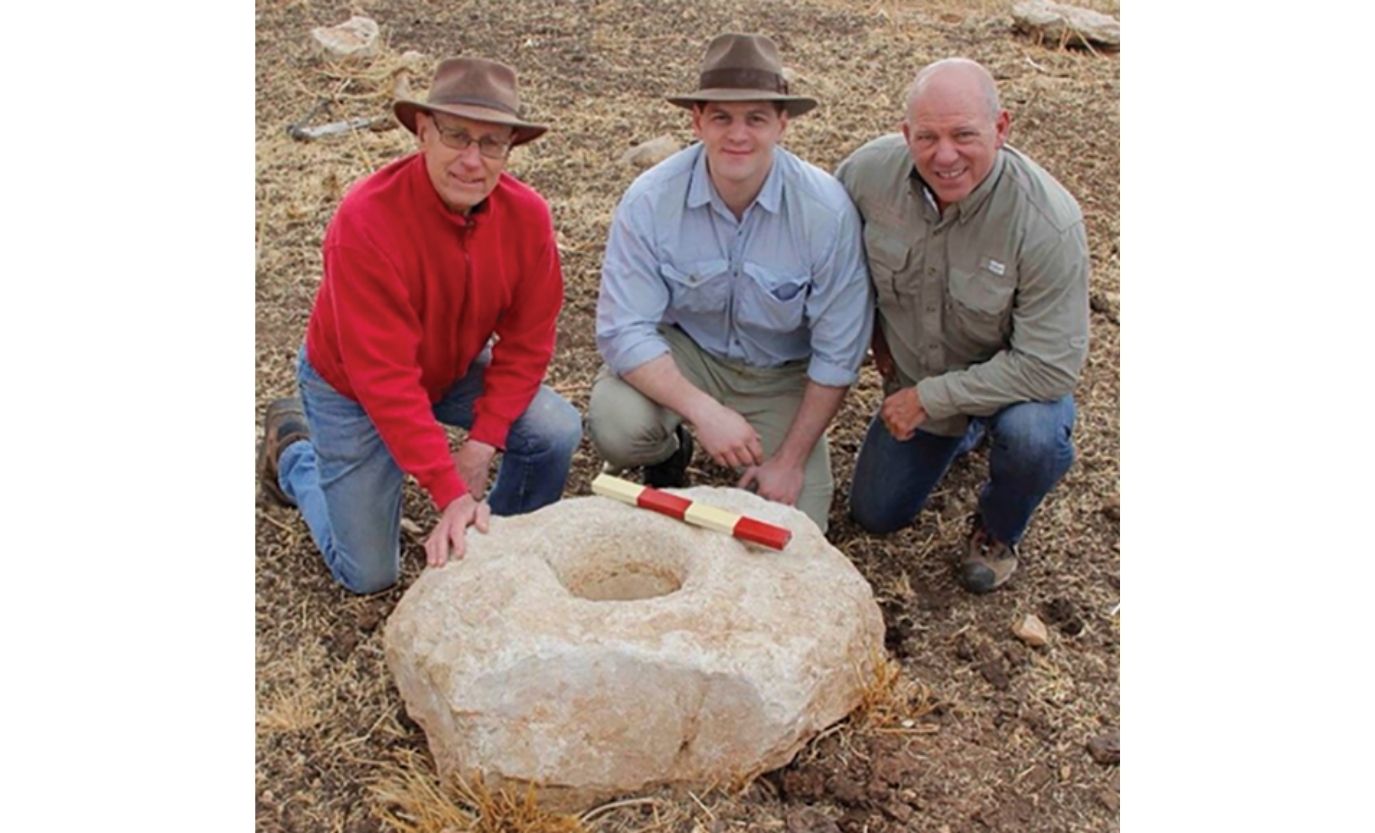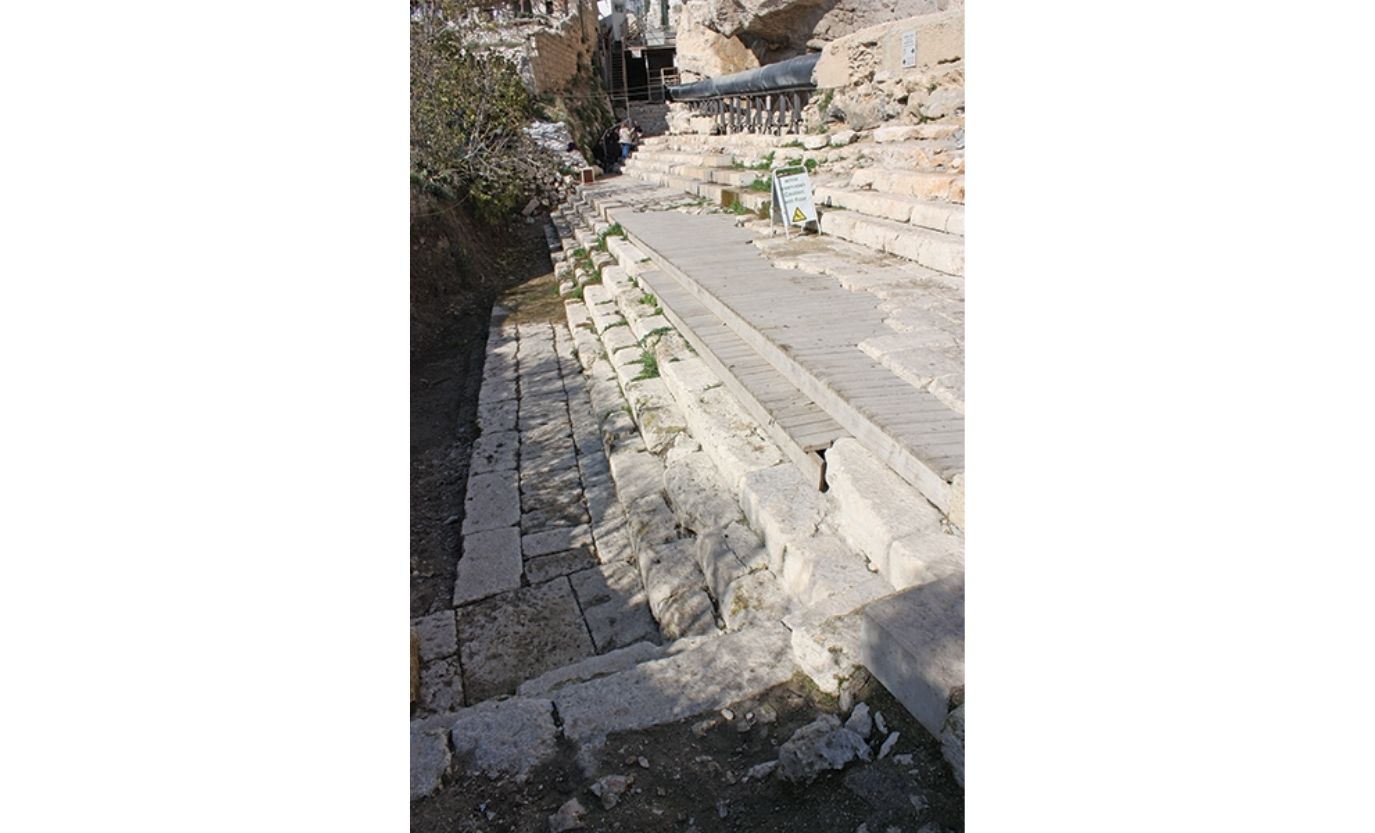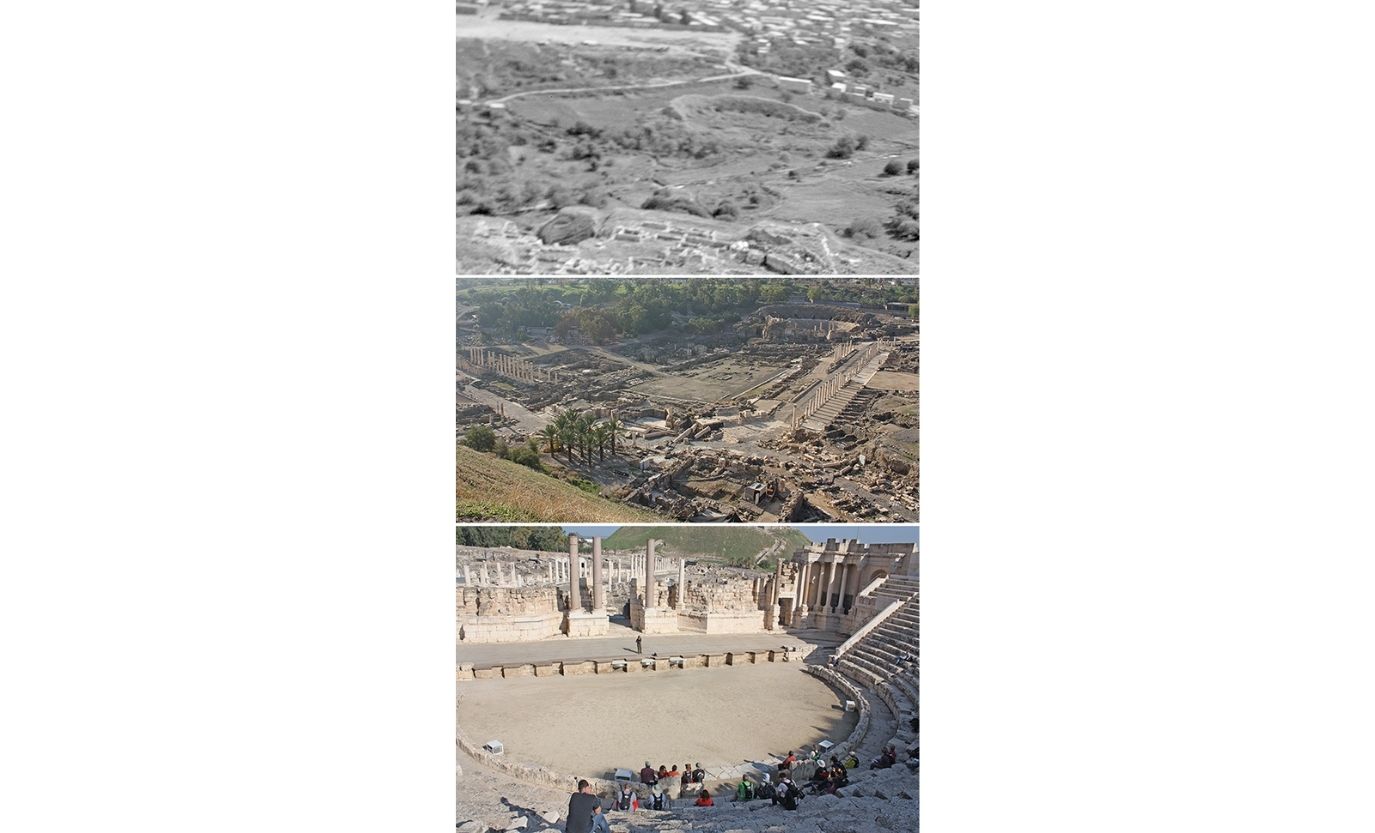Main Photo: Mt. Ebal Defixio Announced: Dr. Scott Stripling at the press conference held in conjunction with the Associates for Biblical Research (ABR) at the Lanier Theological Library in Houston, Texas on 3/24/2022. Numerous members of the press participated live and online from across the U.S. and around the world.
Evidence continues to emerge that shows remarkable alignment with biblical texts
Numerous people and publications discount the historical reliability of the Bible, often based on decades old assertions that cast doubt on the veracity of Scripture. The refrain, “There is no evidence…” commonly precedes skepticism about stories in the book of Genesis, Hebrews in Egypt, the Exodus, the Israelite Conquest, and more.
At the time they were written, many of these statements were not necessarily lies, but assertations based on opinions of interpretations of purportedly demonstrable conclusions. For example, when 20th century excavations at Jericho (an uncontested location) and Ai (a contested location) did not seem to yield evidence matching the biblical stories, widespread doubt about the reliability of the Bible ensued and influenced millions.
However, new evidence, improved archaeological methods, and scientific advances in the decades since – along with reexaminations of old excavations and interpretations of findings – shows remarkable alignment with biblical texts. Archaeological research scheduled for publication this year related to three early Conquest sites have the potential to cause a gigantic tilt in the balance of evidence favoring fact over fiction concerning the historicity of the Bible.
 Ai Socket Stone: One of two gate socket stones discovered in 2016 near a gate complex on the north side of Khirbet-el-Maqatir, mostly likely the biblical city of Ai. (L-R) Bryant Wood, Mark Hassler, and Scott Stripling. Photo by Mike Luddeni.
Ai Socket Stone: One of two gate socket stones discovered in 2016 near a gate complex on the north side of Khirbet-el-Maqatir, mostly likely the biblical city of Ai. (L-R) Bryant Wood, Mark Hassler, and Scott Stripling. Photo by Mike Luddeni.
The Mt. Ebal Curse Tablet
The Associates for Biblical Research (ABR) March 2022 announcement of the discovery of a formulaic curse recovered on a small, folded lead tablet called a “defixio” is extremely significant. Found in December 2019 when The Bible Seminary (TBS) Provost and archaeologist Dr. Scott Stripling led a team in wet sifting discarded material from excavations conducted on Mt. Ebal between 1982 and 1989 by archaeologist Adam Zertal (1936-2015). High-tech scans of the tablet revealed ancient Hebrew script appearing centuries older than any other known texts found in Israel.
According to Deuteronomy 11 and 27, after crossing the Jordan River and entering the Promised Land, the Israelites were instructed to go to Mt. Ebal, build an altar of uncut stones, offer sacrifices, coat stones with plaster, write the words of the Law on them, and conduct a ceremony with six tribes standing on Mt. Gerizim announcing blessings and six tribes standing on Mt. Ebal pronouncing curses. Joshua 8 records the covenant ceremony lead by Joshua in obedience to God’s commands.
Zertal admitted in his book A Nation Born, “My academic background made it difficult for me to accept the idea of Joshua’s altar being a tangible reality…I had argued that the Bible was full of myths.” Yet, when his excavations on Mt. Ebal uncovered a large rectangular altar with an older and smaller round altar centered underneath, along with pieces of plaster with flat surfaces along with other items with cultic significance, Zertal’s perspective changed. In a 2006 interview with Smithsonian Magazine about his Mt. Ebal research and conclusions, he asserted, “If this corroborates exactly what is written in that very old part of the Bible, it means that probably other parts are historically correct. The impact is tremendous.”
Stripling’s team found the defixio among debris from the lower structure Zertal believed was Joshua’s altar. Observing apparent glyptic markings on the outside and knowing that folded tablets often include writing on the inside, he formed a collaboration with four scientists specializing in tomographic scanning from the Academy of Sciences of the Czech Republic (Ivana Kumpova, Jaroslav Valach, Daniel Vavrik, and Michal Vopalensky) and two epigraphers who specialize in deciphering ancient texts (Pieter Gert van der Veen of Johannes Gutenberg-Universität Mainz and Gershon Galil of the University of Haifa).
Since the brittle tablet could not be opened, the scientists performed thousands of scans to recover potential text. The advanced imaging technology is the same X-ray phase-contrast tomography recently used by researchers to decipher charred papyrus scrolls discovered in 1752 in Herculaneum near the Roman city of Pompeii and buried since the 79 A.D. eruption of Mount Vesuvius. The Mt. Ebal curse tablet team worked together to identify letters and decipher the proto-alphabetic inscription, which appears to read as follows:
Cursed, cursed, cursed – cursed by the God YHW.
You will die cursed.
Cursed you will surely die.
Cursed by YHW – cursed, cursed, cursed.
According to Stripling, “These types of amulets are well known in the Hellenistic and Roman periods, but Zertal’s excavated pottery dated to the Iron Age I and Late Bronze Age, so logically the tablet derived from one of these earlier periods. Even so, our discovery of a Late Bronze Age inscription stunned me.” This find predates any previously known Hebrew inscription in Israel by at least 200 years.
Almost immediately Galil recognized the formulaic literary structure of the inscription: “From the symmetry, I could tell that it was written as a chiastic parallelism.” Reading the concealed letters proved tedious, according to van der Veen, “but each day we recovered new letters and words written in a very ancient script.” Daniel Vavrik and his colleagues from Prague ensured the accuracy of the raw data which the team interpreted.
Galil called the discovery “absolutely the most important inscription ever found in Israel” and explained, “The scribe that wrote this could have written every chapter in the Bible. Now no one can claim that the Bible was written in later periods…because they were able to write it very, very early.”
According to Stripling, “One can no longer argue with a straight face that the biblical text was not written until (centuries later), as many higher critics have done, when here we do clearly have the ability to write the entire text at a much, much earlier date.”
If eyewitnesses were literate and could have written biblical texts in their own lifetime, this could seriously challenge the popular Documentary Hypothesis that has helped cast doubt on the historical reliability of the Bible. In addition to the recently published The El-Burnat (A) Structure(s): Joshua’s Altar? by TBS 2021 Valedictorian Abigail Leavitt that provides background research relevant to the Mt. Ebal defixio, Dr. Stripling is co-writing two academic, peer-reviewed articles scheduled for upcoming publication.
 Amenhotep II Egyptian Scarab: Named the 2013 biblical archaeological find of the year. Photo by Mike Luddeni.
Amenhotep II Egyptian Scarab: Named the 2013 biblical archaeological find of the year. Photo by Mike Luddeni.
The Location of Ai
The contested location of this second conquest city may have been solved with archaeological and geographical evidence in a location that does match the biblical accounts. Et-Tell, 10 mi north of Jerusalem, has long prevailed as a leading candidate for Ai, but conclusions that the site was unoccupied at the time of the biblical conquest helped erode belief in the inerrancy of Scripture.
Although assured by archaeologist W.F. Albright that Et-Tell was unquestionably the ancient location of Ai, ABR surveyed additional sites and conducted exploratory excavations in several locations. One site, excavated for 21 years, is Khirbet el-Maqatir, only 0.6 mi west of current day et-Tell. In addition to local tradition that the fortress of Ai in Joshua’s day stood at Khirbet el-Maqatir, the site has a militarily strategic direct line of sight to Jerusalem as well as nearby ruins of a Byzantine Age monastery that suggest historical veneration of that location.
The biblical text offers numerous geographical indicators required to meet the criteria for Ai, including a strategic location near Beth-Aven, near and east of Bethel, near and east of an ambush site, and south of a valley and ridge. Khirbet el-Maqatir unquestionably meets all these criteria.
Archaeological excavations revealed additional indicators that match the biblical text, including evidence the site was inhabited during the Conquest, evidence of a fortification system accessed by a northern gate, a size dwarfed by nearby Gibeon, evidence of conflagration (destruction by burning), and a ruined and desolate location. One reason the site escaped notice for so long is that it is NOT a tell.
The visible debris lying out in the open amidst an orchard and sheep pasture concealed an extensive underground cave system, and only when excavating and turning over the stones did gate sockets, pottery, weaponry, two entrances to the cave system, and other compelling evidence begin to emerge. TBS alum Destry Jackson’s (MABHA 2020) find – an Egyptian scarab found in a sealed locus with pottery dating to the Late Bronze I age (ca. 1485-1400 BC) and dated to the Eighteenth Egyptian Dynasty reign of Amenhotep II (ca. 1455-1418 BC) – topped the list of discoveries in biblical archaeology in 2013 according to Christianity Today.
“The geography and archaeology of Khirbet el-Maqatir accord with the descriptions of Ai in Joshua 7–8,” says Stripling, Director of Excavations at the site. “The identification of Khirbet el-Maqatir as the Ai of Joshua’s time resolves the problems of chronology and location (and) squares with the biblical data concerning the exodus and conquest.”
The final archaeological report of Khirbet el-Maqatir excavations is scheduled for publication in 2022. For anyone who has questioned the reliability of Scripture because of the “problem of Ai,” looking in the right place – in this case, just a few thousand feet away from a misidentified location – will prove to have significantly helped solve the problem.
 Pool of Siloam: Although referenced in the Bible and elsewhere, skeptics long doubted the existence of this pool until it was discovered by accident in southern Jerusalem while repairing a sewer system in 2004 (see pipes in photo). Excavations revealed a width of 225’ and steps on at least three sides. A major portion of the pool is as yet unexcavated due to political issues.
Pool of Siloam: Although referenced in the Bible and elsewhere, skeptics long doubted the existence of this pool until it was discovered by accident in southern Jerusalem while repairing a sewer system in 2004 (see pipes in photo). Excavations revealed a width of 225’ and steps on at least three sides. A major portion of the pool is as yet unexcavated due to political issues.
Tel Shiloh Excavations
ABR’s consortium led by Stripling have also been excavating since 2017 at Tel Shiloh, where the tabernacle resided for more than 300 years. This excavation is still very much in process and interesting finds continue to bolster scriptural veracity for those willing to consider such a view possible. For example, due east of intriguing structural remains (aligned due east and west and similar in foundation dimensions to the tabernacle) lies an extremely large and ashy debris pit excavated by a previous archaeologist who believes the patriarchal narratives are powerful literary achievements but certainly not historical. He interpreted his finds as evidence of long-time Canaanite, not Jewish, worship, while also noting the absence of certain period markers elsewhere on the site.
However, his own analysis of the bones in the favissa (sacred deposit) reveal a preponderance of right-sided sheep and bovine remains, which also correspond with a noticeable drop in pig bones around the time the Israelites would have entered the region. The pit also includes an unusual number of lightly used clay vessels that appear to have been broken when deposited.
This evidence matches instructions in Leviticus that include depositing ashes of offerings due east of the altar (perhaps due to prevailing winds blowing west to east?), allocating the breast and right thigh of sacrifices to priests and their sons to eat in the courtyard area of the sanctuary, prohibition against eating pork, and destroying clay pots after one-time use (as opposed to metal vessels able to be washed and reused without contamination).
Like the Mt. Ebal project, the current team is using wet sift technology to sort through debris piles from earlier digs at Shiloh. The finds so far include numerous expected period markers such as datable Egyptian scarabs, pottery, bones, coins, seeds, and other items missed during previous excavations. Even more compelling evidence emerged when the team found three altar horns during excavation of squares in the vicinity of the intriguing structure currently scheduled for excavation during the 2022 summer dig. Visit DigShiloh.org for articles, photos, and videos, including the Digging for Truth TV series and episodes of the Shiloh Network News.
 Beit She’an: (Top) Early 1900’s photo prior to excavations with the ancient tell in the foreground, city buildings near the top, and filled in valley with a noticeably large semi-circular mound of rocks; (Middle) Recent photo from the tell revealing emerging ruins of an extensive Roman city from the time of Jesus; (Bottom) Excavated and restored theatre with tell in the background.
Beit She’an: (Top) Early 1900’s photo prior to excavations with the ancient tell in the foreground, city buildings near the top, and filled in valley with a noticeably large semi-circular mound of rocks; (Middle) Recent photo from the tell revealing emerging ruins of an extensive Roman city from the time of Jesus; (Bottom) Excavated and restored theatre with tell in the background.
Right Place, Right Times, Informed Theology
The past few decades have proven that looking in the right place, in the right time periods, and using improved tools and technologies, new excavations and reexaminations of old findings provide increasing evidence that bolsters the historical reliability of Scripture. Not just small objects, but structures such as the Pool of Siloam and the recently opened Pilgrim’s Road of ascents tunnel up to the Temple Mount in Jerusalem; remains of fortresses such as Tel Balata (biblical Shechem), tombs such as Herodium, and palaces such as Caesarea Maritima; and cities such as Beit She’an (Roman Scythopolis) have been exposed from their hiding places underneath sand, soil, and later settlements.
The Bible Seminary’s educational initiatives include equipping and training leaders familiar with scripture, history, and increasing archaeological evidence. Through teaching, as well as publishing articles, books, music, podcasts, research papers, study notes in Bibles, videos, social media and more, TBS is working to improve pathways to faith by paving them with facts.
For example, the Joshua’s Conquest Seminar scheduled at Parkway Fellowship Church in Richmond, Texas August 5-6, 2022 will be taught by Dr. Stripling and focus on the internal biblical chronology and external archaeological evidence of the Conquest as presented in the book of Joshua.
Truth can shake foundations of doubt that rest on dismissed, missing, or mis-matched data. With only an estimated 5% of the Holy Land excavated – along with increasing evidence that the Bible is factually accurate, historically reliable, and that the Bible’s earliest books could have been written by eyewitnesses – ongoing research exposing what else lies beneath will continue to unsettle skeptics and strengthen the faith of believers.



